高中英语人教版必修三教案:Unit3 reading
- 格式:doc
- 大小:88.00 KB
- 文档页数:3

2019新人教高中英语必修三Unit3 Diverse CulturesReading for writing 公开课教案Teaching aims:1.Enable students to acquire some basic information about San Francisco’s Chinatown.2.Enable students to figure out the organisation and language feature of the text.3.Help students to identify the cultural characteristics of Chinatown and the relationship between Chinese culture and American multiculturalism.4.Guide students to write an introduction to your city/town and write an outline of your introduction.Teaching key points:1.Analyse the organisation and language feature of the text.2.Cultivate students to write an introduction to your city/ town properly and concisely according to an actual situation.Teaching difficult points:1.Enable students to figure out the organisation and language feature of the text.2.Guide students to introduce their city or town in a comprehensive,accurate and organised way.Teaching procedures:StepⅠBefore readingTalk about your travel experience and ask students to give you some advice and information as you plan to travel to San Francisco’s Chinatown.T:Class, I plan to travel to America and my destination will be Chinatown in San Francisco. How do you know about Chinatown? Can you give me some advice and information to help me know more about Chinatown?Ss: Firstly, it is the place where the Chinese immigrants live. Secondly, you canexplore the interesting sights,experience traditional Chinese culture, go shopping, eat Chinese food, and so on.Step ⅠWhile readingCultural NoteThe Dragon Gate is the most photographed site in San Francisco’s Chinatown.The gate was designed by three Chinese-American architects in 1967 using traditional Chinese village gates for inspiration.The Tin How Temple is the oldest Taoist temple in Chinatown,and one of the oldest Chinese temples in the United States.The temple was built in 1852,but then destroyed by the 1906 earthquake.The image of the goddess Mazu was preserved,as well as part of the altar and the bell.These were relocated to the top floor of a building constructed on the site of the old temple.The Bank of Canton is actually the old Chinese Telephone Exchange,a traditional Chinese-style building constructed in 1894.When the telephone was first introduced,there was no way to dial a number.Instead,you would have to talk to a switchboard operator (nearly always a woman),tell her the telephone number of the person you wanted to talk to,and she would manually connect you to the person you wanted to call using an electric plug.However,Chinese residents thought it was impolite to use a number to refer to a person,so the switchboard operators in Chinatown had to know all the names and addresses of everyone in Chinatown so they would know who to connect people to.They also had to know five dialects of Chinese and speak English.Like many buildings in Chinatown,the Chinese Telephone Exchange was destroyed by the 1906 earthquake,but it was quickly rebuilt.However,in 1949 it was closed when dial telephones made switchboards unnecessary.Portsmouth Square,now a public park,is the site of San Francisco’s first public square,built in the early 19th century.While many important historical events related to California and San Francisco occurred in the square before Chinatown was established or grew in size,the site is now very much considered an integral part of Chinatown.The Scottish novelist Robert Louis Stevenson (1850—1894) lived in San Francisco briefly between 1879—1880,and spent much time in Portsmouth Square during his stay there.There is a monument in his honour in the park.Activity 1Prediction1.Look at the title and picture and predict what kind of article is this?2.Who are the target readers?3.What is the writer’s purpose of writing this text?Suggested answers:1.This is an introduction to Chinatown in San Francisco.2.Visitors.3.To introduce a diverse cultural Chinatown in San Francisco to visitors.Activity 2 Reading for main ideaRead the text quickly and match the main idea of the passage.Para.1 A.The characteristic of Chinatown.Para.2 B.The history of Chinatown.Para.3 C.The introduction of Chinatown’s shops and products.Para.4 D.The origin of Chinatown.Para.5 E.The existence value of Chinatown.Para.6 F.The famous food and drinks of Chinatown.Suggested answers:Para.1:A Para.2:D Para.3:B Para.4:C Para.5:F Para.6:EActivity 3 Reading for detailsRead the passage again and answer the questions.1.What are the famous tourist sites in the Chinatown of San Francisco?2.Which is the best season to visit the Chinatown in San Francisco?3.What else can you do there?Suggested answers:1.Dragon Gate,Tin How Temple,Bank of Canton,and Portsmouth Square.2.All year round.3.We can explore the interesting sights,experience traditional Chinese culture,goshopping,eat Chinese food,and so on.Activity 4Reading for organisation and language featuresRead the text again and study the organisation and language feature.1.What information is included in the introduction? Tick the items that are mentioned.2.Underline the sentences that are used to describe the items above.Location:______________________Climate:________________________________History:_____________________________________Ethnic groups:____________________________________Languages:_____________________________________________Famous figures:_____________________________________________Famous food/drink:_______________________________________________ Tourist attractions:_________________________________________________ Businesses and industries:_____________________________________________3.Fill in the blanks to show the structure of the text.Paragraph(s)Main ideaDetails Expressions1 Introductionsh ortintrodu ction to San Francisc o’s Chinato wn2—5 Bodywhat youcan findand doin San Francisco’sChina-town23456 Summaryim portanc e of Chinato wnSuggested answers: 1.2.Location:in San FranciscoClimate:mild all year roundHistory:Chinese immigrants settled in the area during the railroad construction and gold rush periodEthnic groups:the majority of residents in Chinatown are still ethnic ChineseLanguages:many of whom do not speak English fluentlyFamous figures:Robert LouisFamous food/drink:traditional dishes from all over ChinaTourist attractions:Dragon Gate,Tin How Temple,Bank of Canton,Portsmouth SquareBusinesses and industries:souvenirs,goods,and clothing;all kinds of traditional Chinese herbal medicine;Chinese tea stores3.Pa ragraph (s)MainideaDetails Expressions1Int roducti onshortintroduction toSanFrancisco’sChinatownlocation,features,climatebiggest,oldest,very popular tourist draw,mild allyear round2—5what you2history,ethnichistorically...what started as...then turnedinto...the majority of residents...a real taste of ChinaBo dy canfindand doin SanFrancisco’sChinatowngroups,language3attractions,famous figuresfamous sites include....to name but a few,spendhours just exploring the interesting sights,smells,andsounds of China,a key site.a great place to...4storesand goodsoffer a unique range of...all kinds of...can befound,varieties of5foodtreasure,suit everyone’s taste,traditional dishesfrom all over China6 Summa ryimportance ofChinatownuniquecultureallow...to...experience...first handStepⅠ Describing a place with distinctive cultural identity1.In groups,brainstorm as much information as possible about your city/town and its culture.Then write an outline of your introduction.①What is unique about your city/town?②Is it a city/town with diverse cultures?③What examples can you give to illustrate its feature?2.Write an introduction to your city/town.The following phrases and expressions may help you.·is located in/on·has a history of...years·is divided up into·has a population of·is...in size·is home to...ethnic groups·the most popular/greatest/largest·popular festivals/foods/tourist sights include...Suggested answers:1.①My city is distinctive cultural identity.②Yes,it is a city/town with diverse cultures.③I will give examples such as history,population...to illustrate its features.2.Lijiang is an ancient city high up in the mountains of Yunnan,near the borders of Sichuan and Tibet.It was an important stop on the Ancient Tea and Horse Road,which connected central China with Myanmar and India,transporting not just tea but also silk and other goods.Lijiang’s Old Town,with a history of over 800 years,is a UNESCO World Heritage Site.Today,Lijiang is mostly known for its ethnic minority culture,especially the culture of the Naxi ethnic group.The Naxi are famous for their Dongba culture.They have their own unique written language that uses pictures and symbols.They also create beautiful arts and crafts,and are well known for their singing and dancing.Strolling around the Old Town,one can witness Naxi life much as it was hundreds of years ago.One can also try traditional Naxi food,including the air-dried pork liver,Naxi baba (a kind of flat bread),and Naxi hot pot.But if you really want to see Naxi traditional culture,it is best to visit during the Torch Festival,which usually occurs in the summer.During the festival,the streets are full of torches,bonfires,and lots of people singing and dancing.While the main ethnic group living in the area is the Naxi,there are also at least 19 other ethnic groups,including Yi,Lisu,Bai,Tibetan,and Pumi.It is easy to arrange a short homestay with an ethnic minority family to learn more about their way of life.Just outside the city,there are beautiful mountains,meadows,lakes,rivers,and gorges,offering plenty of opportunities to go hiking,kayaking,or rafting.Like much of Yunnan,the weather is always fairly mild in Lijiang,so it is fine to visit throughout the year.Lijiang can be easily reached by airplane or train,and visitors can hire bikes or cars to explore the area.It is the perfect place for tourists to experience the colourful culture of China’s ethnic minorities.StepⅠEvaluating and polishing the draft1.Exchange drafts with a e the checklist to give feedback on your partner’s draft.2.Get your draft back and revise it.3.Put up your introduction in your classroom or share it with the class.StepⅠHomework书面表达:请阅读下面有关中国题材纪录片(documentary)的对话,并按照要求用英语写一篇150个词左右的文章。
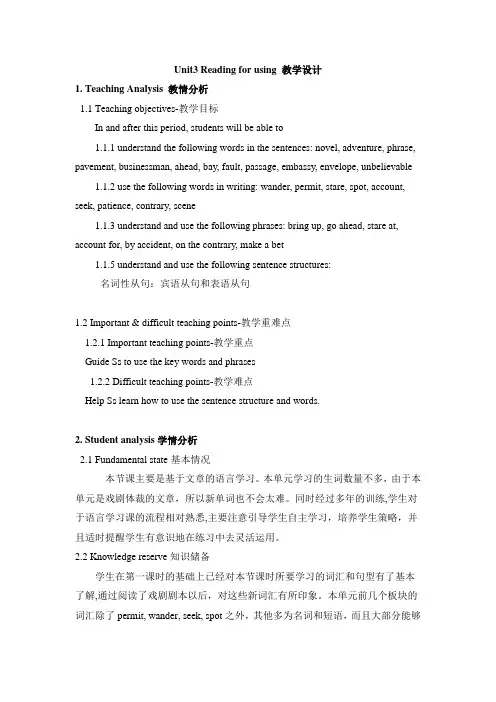
Unit3 Reading for using 教学设计1. Teaching Analysis 教情分析1.1 Teaching objectives-教学目标In and after this period, students will be able to1.1.1 understand the following words in the sentences: novel, adventure, phrase, pavement, businessman, ahead, bay, fault, passage, embassy, envelope, unbelievable1.1.2 use the following words in writing: wander, permit, stare, spot, account, seek, patience, contrary, scene1.1.3 understand and use the following phrases: bring up, go ahead, stare at, account for, by accident, on the contrary, make a bet1.1.5 understand and use the following sentence structures:名词性从句:宾语从句和表语从句1.2 Important & difficult teaching points-教学重难点1.2.1 Important teaching points-教学重点Guide Ss to use the key words and phrases1.2.2 Difficult teaching points-教学难点Help Ss learn how to use the sentence structure and words.2. Student analysis学情分析2.1 Fundamental state基本情况本节课主要是基于文章的语言学习。
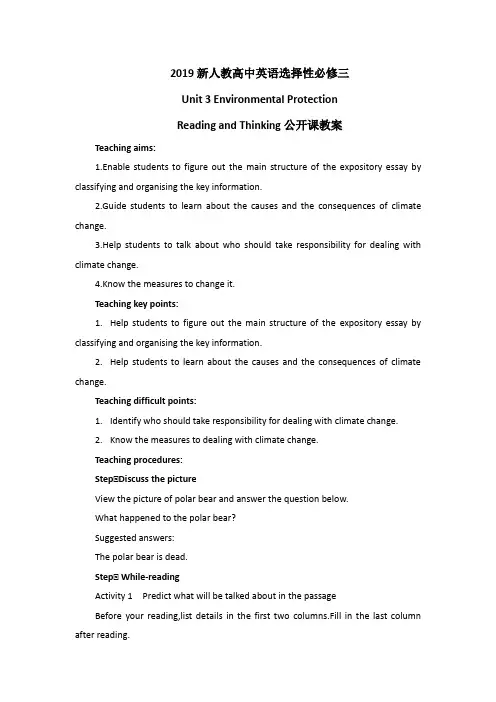
2019新人教高中英语选择性必修三Unit 3 Environmental ProtectionReading and Thinking公开课教案Teaching aims:1.Enable students to figure out the main structure of the expository essay by classifying and organising the key information.2.Guide students to learn about the causes and the consequences of climate change.3.Help students to talk about who should take responsibility for dealing with climate change.4.Know the measures to change it.Teaching key points:1.Help students to figure out the main structure of the expository essay by classifying and organising the key information.2.Help students to learn about the causes and the consequences of climate change.Teaching difficult points:1.Identify who should take responsibility for dealing with climate change.2.Know the measures to dealing with climate change.Teaching procedures:StepⅠDiscuss the pictureView the picture of polar bear and answer the question below.What happened to the polar bear?Suggested answers:The polar bear is dead.StepⅠ While-readingActivity 1Predict what will be talked about in the passageBefore your reading,list details in the first two columns.Fill in the last column after reading.Climate changeWhat I Know (K)What I Want to Know (W)What I Have Learnt (L)Look at the title “Climate Change Requires the World’s Attention” and the two pictures on Page 26,answer the following questions.1.Where would you most likely find this text?2.What information can you get from the title?3.What do you think will be talked about?Suggested answers:Activity 1Climate changeWhat I Know (K)What I Want toKnow (W)What I Have Learnt (L)Climate change requires more attentionI want to knowmore consequences ofclimate changePolar bearGlobal warming1.In a newspaper.2.Climate change requires more attention.3.The text will talk about the climate change and environmental problems. Activity 2Reading for the structureSkim the text and find the main idea of each paragraph.Suggested answers:Paragraph 1 & Paragraph 2:AParagraph 3:DParagraph 4:BParagraph 5:CActivity 3Focus on the “evidence”Read Paragraph 1 & Paragraph 2 and answer the question.Who:global surface temperature1.What:happened to the global surface temperature?Read the Paragraph 1 &Paragraph 2 again and answer the questions.Who:polar bear2.What:happened to the polar bear?3.Why:did the writer write about it?Suggested answers:1.There is little doubt that Earth is getting warmer and warmer.2.The bear appeared to have starved and died.3.The answers vary.Activity 4Focus on the “causes”Read Paragraph 3 and answer the questions with mind maps.1.Why is the natural greenhouse effect important and necessary?2.What are the consequences of high greenhouse gas emissions?Suggested answers:(1)keeping Earth climate warm and habitable(2)man-made greenhouse(3)causing Earth’s surface temperature to rise quickly if too much heat energy is trappedActivity 5Focus on the “consequences”Read Paragraph 4 carefully and fill in the mind maps.The rise in temperature:weather/naturalextreme ,heatserious ,costing ,economicSuggested answers:rainstorms weather/natural disastersextreme rainstorms,heat wavesserious damage,costing human lives,economic lossesActivity 6 Focus on the “measures”Read Paragraph 5 carefully and find out the measures.measures { Governments:Weasindividuals: ...Suggested answers:Governments need to consider making policies and taking appropriate actions and measures to reduce gas emissions.We as individuals can also reduce our “carbon footprint” by restricting the amount of carbon dioxide.Activity 7 Focus on the “expository”Paragraph 1 & Paragraph 2:Paragraph 3:Paragraph 4:Paragraph 5:Suggested answers:Paragraph 1 & Paragraph 2:evidenceParagraph 3:causesParagraph 4:consequencesParagraph 5:measuresStep Ⅰ Post-reading—Critical ThinkingDiscuss these questions in groups.1.Do you think climate change is the result of human activity?Give your reasons.2.Who do you think should take responsibility for dealing with climate change?3.What can we do?Suggested answers:1.The answers vary.2.People.3.The answers vary.StepⅠ HomeworkFinish what you have learnt in the last column of KWL chart.Suggested answer:I have learnt many useful words and expressions to describe the climate change and I will find out more measures to protect environment as individuals.。
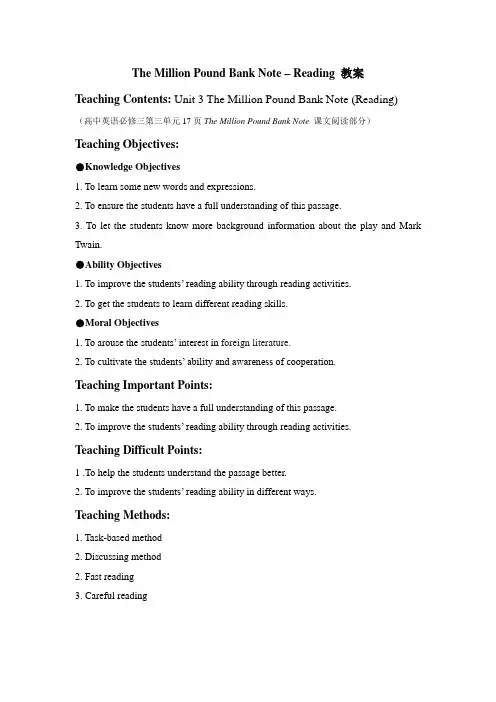
The Million Pound Bank Note – Reading 教案Teaching Contents: Unit 3 The Million Pound Bank Note (Reading)(高中英语必修三第三单元17页The Million Pound Bank Note课文阅读部分)Teaching Objectives:●Knowledge Objectives1. To learn some new words and expressions.2. To ensure the students have a full understanding of this passage.3. To let the students know more background information about the play and Mark Twain.●Ability Objectives1. To improve the students’ reading ability through reading activities.2. To get the students to learn different reading skills.●Moral Objectives1. To arouse the students’ interest in foreign literature.2. To cultivate the students’ ability and awareness of cooperation.Teaching Important Points:1. To make the students have a full understanding of this passage.2. To improve the students’ reading ability through reading activities.Teaching Difficult Points:1 .To help the students understand the passage better.2. To improve the students’ reading ability in different ways.Teaching Methods:1. Task-based method2. Discussing method2. Fast reading3. Careful readingTeaching Aids:1. Multi-media facilities2. A blackboard3. Textbook and Exercise booksTeaching procedures:Step I Greeting and leading in (6 minutes)1. Greeting2. Watch a short video about Mark Twain. (Ask the students to pay attention to the details about Mark Twain.)3. Tell something about Mark Twain.Step II Fast Reading (10 minutes)1.Ask the students to read the first paragraph quickly and find the time and the maincharacters of this passage.2.Ask the students to scan the whole passage and choose the best answers.3.Teacher guide the students how to find the answers.StepⅢCareful Reading (20 minutes)1. Ask the students to read the whole passage carefully and try to answer the given questions.2. Ask the students to read the passage and put the following statements in the correct order according to the development of the story. (Ask the students to discuss it with their desk mates) 同步训练第38页3.Ask the students to read the passage and try to write down the main idea of the passage. (Fill in the blanks)StepⅣ Summary (8 minutes)1.Ask the students to finish the exercise in the exercise book. (一线精练第17页)2.Teacher gives the answers and correct.Step ⅤHomework (1 minute)1. Think about what kind of person Henry was? Give at least two reasons.2. Can you guess the following story? Write at least 5 sentences.。
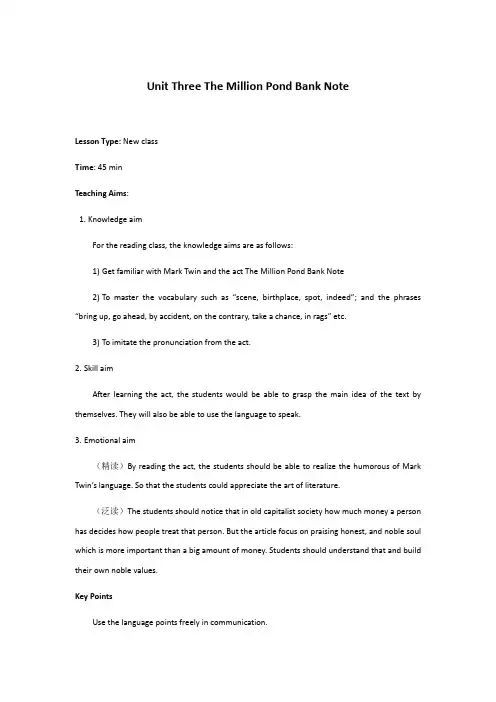
Unit Three The Million Pond Bank NoteLesson Type: New classTime: 45 minTeaching Aims:1. Knowledge aimFor the reading class, the knowledge aims are as follows:1)Get familiar with Mark Twin and the act The Million Pond Bank Note2)To master the vocabulary such as “scene, birthplace, spot, indeed”; and the phrases “bring up, go ahead, by accident, on the contrary, take a chance, in rags” etc.3)To imitate the pronunciation from the act.2.Skill aimAfter learning the act, the students would be able to grasp the main idea of the text by themselves. They will also be able to use the language to speak.3.Emotional aim(精读)By reading the act, the students should be able to realize the humorous of Mark Twin’s language. So that the students could appreciate the art of literature.(泛读)The students should notice that in old capitalist society how much money a person has decides how people treat that person. But the article focus on praising honest, and noble soul which is more important than a big amount of money. Students should understand that and build their own noble values.Key PointsUse the language points freely in communication.Difficult PointsAct the scenes with emotion and authentic pronunciation.Teaching Tools:radio, ppt, videoTeaching Methods: Task-based teaching method, audio-lingual method.Teaching Procedures:I. Warming upAt the beginning of the class, the teacher will ask students imagine what are they going to do if someone gives them 10 million RMB. After the discussion, the students would be interested in the topic, then the teacher lead students to focus on the text book.II. Presentation and practice1.Pre-readingT: Do you know anything about Mark Twin the author of the play Ten Million Pound Bank Note?S1: No.S2: Yes, he’s an American writer.T: Great! So do you know what kind of works does he have?S2: Novels, plays.T: Excellent. He’s famous for writing humorous and critical themes. We are going to find out if there’s humorous and critical signs in this play Ten Million Pound Bank Note. Now we are going to listen to the tape. For this time, find out the words you may not familiar with and guess what they mean.2. While readingWhile listening to the tape and looking at the play the students will find out some words that they are not familiar with. For example, go ahead.T: Where do you find the phrase “go ahead”?S1: From the conversation “I wonder, Mr Adams, if you’d mind us asking a few questions.--Not at all. Go right ahead.”T: Ok, then tell me please if Mr Adams mind their asking questions?S2: No, he doesn’t mind cuz he said “not at all”.T: Very keen observation. Ok, then imagine if you were Adams, what are you gonna say after saying you don’t mind?S1: You can ask me.T: Very brilliant. Yes, “go ahead” actually means “do what you want to do”, like “just do it”. For example, I ask “ Can I open the door?” And you answer?Ss: Go ahead.T: Meaning?Ss: You can open the door.T: Very good! You guys are so smart!Then the teacher is going to teach other new words by leading the students to find out the answers by themselves.3.Role playMost of the students would have chances to have a role in this scene. The students would be separated into four groups. The four groups will practice first then finish the whole play.During this time, the students should learn deeper about the play. The main idea and writing style of the play will be grasped by the students.The teacher will play the tape again and tell the class that they need to focus on the imitation. The teacher may provide some modal pronunciationIII. SummaryAsk the students what words they’ve learned and how they understand the words, then the students should also talk about what’s the most important in a play.IV. HomeworkWrite a short play about what will happen next after the scene they’ve learned in this class. Blackboard LayoutUnit Three Ten Million Pond Bank NoteBirthplaceSpotIndeedBring upGo aheadBy accidentOn the contrary。

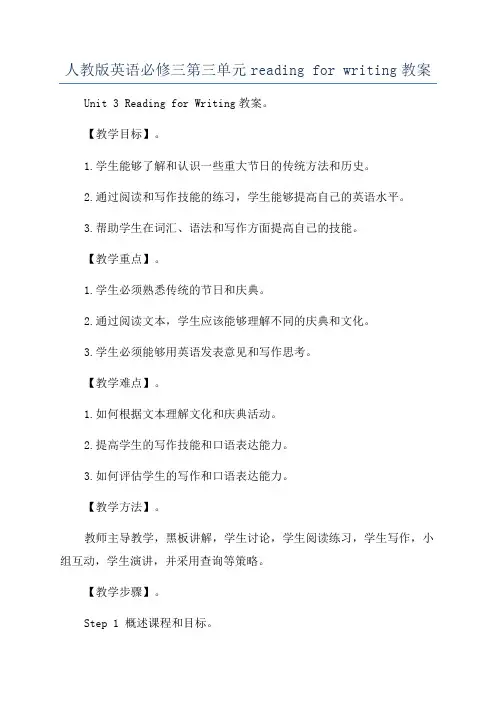
人教版英语必修三第三单元reading for writing教案Unit 3 Reading for Writing教案。
【教学目标】。
1.学生能够了解和认识一些重大节日的传统方法和历史。
2.通过阅读和写作技能的练习,学生能够提高自己的英语水平。
3.帮助学生在词汇、语法和写作方面提高自己的技能。
【教学重点】。
1.学生必须熟悉传统的节日和庆典。
2.通过阅读文本,学生应该能够理解不同的庆典和文化。
3.学生必须能够用英语发表意见和写作思考。
【教学难点】。
1.如何根据文本理解文化和庆典活动。
2.提高学生的写作技能和口语表达能力。
3.如何评估学生的写作和口语表达能力。
【教学方法】。
教师主导教学,黑板讲解,学生讨论,学生阅读练习,学生写作,小组互动,学生演讲,并采用查询等策略。
【教学步骤】。
Step 1 概述课程和目标。
教师向学生介绍第三单元的主题,根据课程目标和学生预期的技能水平,让学生明确学习目标和期望能够达到的技能和知识。
Step 2 学术词汇表和口头表达。
教师为学生提供一个专业术语的列表,这些术语与节日和庆典有关,或与文化和习俗有关。
教师会冷静地对每一个术语进行解释。
后,要求学生反复说这些术语,以尽量熟练掌握,并进行口头练习,确保学生能够在英语中表达自己的想法。
Step 3 阅读理解和分析。
教师分配课文,有可能包括多个篇章,帮助学生用所学的技能加深对文本的理解和评估。
教师可以要求学生回答问题,或寻找关键内容。
学生们可以自由地解释课文。
教师可以通过黑板引导讨论,协助学生更好地理解文本。
Step 4 串讲和口头演讲。
要求学生口述内容,并向同学们展示他们的批判性思维,看看他们能否进一步理解所学到的新知识。
通过“串课”和口头演讲,学生可以更深入地了解自己的思维和理解。
Step 5 搜集资料、撰写文章。
学生阅读文本,了解庆典和历史文化的细节,并搜集资料,构建自己的写作思路,写下自己的文章。
Step 6 小组分享和讨论。
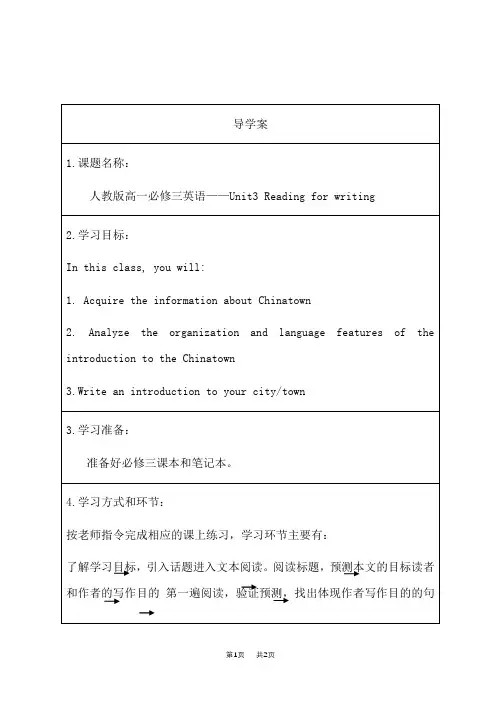
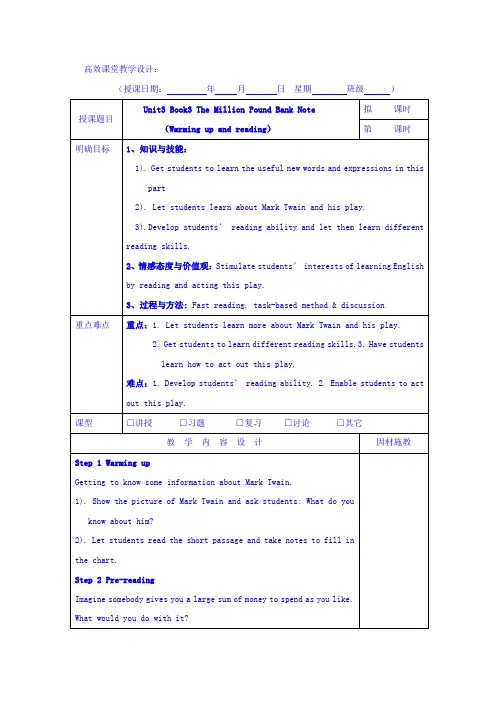
高效课堂教学设计:(授课日期:年月日星期班级)品味人生1、不管鸟的翅膀多么完美,如果不凭借空气,鸟就永远飞不到高空。
想象力是翅膀,客观实际是空气,只有两方面紧密结合,才能取得显着成绩。
2、想停下来深情地沉湎一番,怎奈行驶的船却没有铁锚;想回过头去重温旧梦,怎奈身后早已没有了归途。
因为时间的钟摆一刻也不曾停顿过,所以生命便赋予我们将在汹涌的大潮之中不停地颠簸。
3、真正痛苦的人,却在笑脸的背后,流着别人无法知道的眼泪,生活中我们笑得比谁都开心,可是当所有的人潮散去的时候,我们比谁都落寂。
4、温暖是飘飘洒洒的春雨;温暖是写在脸上的笑影;温暖是义无反顾的响应;温暖是一丝不苟的配合。
5、幸福,是一种人生的感悟,一种个人的体验。
也许,幸福是你风尘仆仆走进家门时亲切的笑脸;也许,幸福是你卧病床上百无聊赖时温馨的问候;也许,幸福是你屡遭挫折心灰意冷时劝慰的话语;也许,幸福是你历经艰辛获得成功时赞赏的掌声。
关键的是,你要有一副热爱生活的心肠,要有一个积极奋进的目标,要有一种矢志不渝的追求。
这样,你才能感受到幸福。
6、母爱是迷惘时苦口婆心的规劝;母爱是远行时一声殷切的叮咛;母爱是孤苦无助时慈祥的微笑。
7、淡淡素笺,浓浓墨韵,典雅的文字,浸染尘世情怀;悠悠岁月,袅袅茶香,别致的杯盏,盛满诗样芳华;云淡风轻,捧茗品文,灵动的音符,吟唱温馨暖语;春花秋月,红尘阡陌,放飞的思绪,漫过四季如歌。
读一段美文,品一盏香茗,听一曲琴音,拾一抹心情。
8、尘缘飞花,人去楼空,梦里花落为谁痛?顾眸流盼,几许痴缠。
把自己揉入了轮回里,忆起,在曾相逢的梦里;别离,在泪眼迷朦的花落间;心碎,在指尖的苍白中;淡落,在亘古的残梦中。
在夜莺凄凉的叹息里,让片片细腻的柔情,哽咽失语在暗夜的诗句里。
9、用不朽的“人”字支撑起来的美好风景,既有“虽体解吾犹未变兮”的执着吟哦,也有“我辈岂是蓬蒿人”的跌宕胸怀;既有“我以我血荐轩辕”的崇高追求,也有“敢教日月换新天”的豪放气魄。
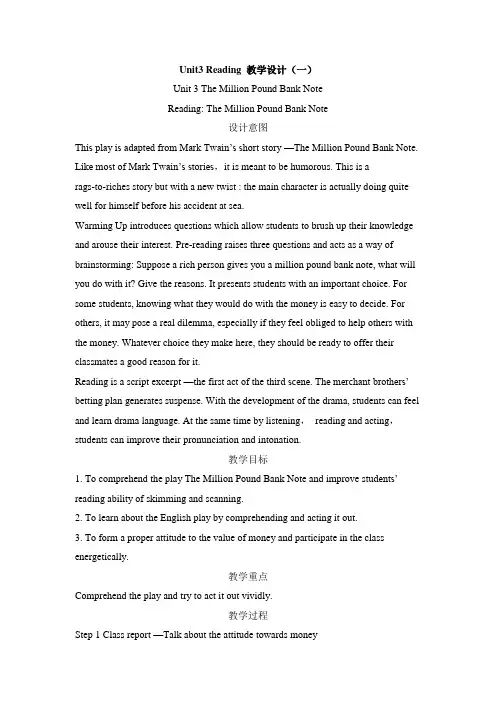
Unit3 Reading 教学设计(一)Unit 3 The Million Pound Bank NoteReading: The Million Pound Bank Note设计意图This play is adapted from Mark Twain’s short story —The Million Pound Bank Note. Like most of Mark Twain’s stories,it is meant to be humorous. This is arags-to-riches story but with a new twist : the main character is actually doing quite well for himself before his accident at sea.Warming Up introduces questions which allow students to brush up their knowledge and arouse their interest. Pre-reading raises three questions and acts as a way of brainstorming: Suppose a rich person gives you a million pound bank note, what will you do with it? Give the reasons. It presents students with an important choice. For some students, knowing what they would do with the money is easy to decide. For others, it may pose a real dilemma, especially if they feel obliged to help others with the money. Whatever choice they make here, they should be ready to offer their classmates a good reason for it.Reading is a script excerpt —the first act of the th ird scene. The merchant brothers’ betting plan generates suspense. With the development of the drama, students can feel and learn drama language. At the same time by listening,reading and acting,students can improve their pronunciation and intonation.教学目标1. To comprehend the play The Million Pound Bank Note and improve s tudents’ reading ability of skimming and scanning.2. To learn about the English play by comprehending and acting it out.3. To form a proper attitude to the value of money and participate in the class energetically.教学重点Comprehend the play and try to act it out vividly.教学过程Step 1 Class report —Talk about the attitude towards money(设计意图: 通过“课前汇报”的形式,引出本堂课的话题,同时检查学生课前自主学习的效果。

教学设计Reading课前准备1.学生的学习准备。
把学生分成四人一组,去查阅有关Mark Twain的相关内容。
2.教师的教学准备:认真备好课,上网搜集有关Mark Twain的资料及与《百万英镑》有关的图片、评论和VCD。
3.把教室座位设计成四人一组的方式,使学生相向而坐。
4.教具准备。
准备好多媒体所需的各种设备。
教学过程第一步呈现Tell students about Mark Twain;give a brief introduction of him.Mark Twain is probably one of the few American writers with whom you are already familiar.The following questions are designed to find out how much you know about this writer and decide how much more you need to know about the author.第二步热身练习Show some pictures of the film “The Million Pound Bank Note”,and ask the students to talk about them in their own words.Then ask them to imagine what they would do if they got one million pounds.第一环节,导入与热身。
通过图片及问题,让学生对Mark Twain有一个初步的了解,并由此激发他们的求知欲。
学生回答这一问题可以让学生积极参与进来,让课堂达到热身的目的,为下一阶段的学习扫平障碍。
第三步读前活动Get students to discuss the questions in Pre-reading on Page 17 with their partners and then ask them to report their work.Encourage them to express their opinions freely.A short introduction to arouse their interest and curiosity:This play is adapted from Mark Twain's short story by the same title.Like most of Twain's stories,it is meant to be humorous.This is a rags-to-riches story but with a new twist:the hero,Henry,is actually doing quite well for himself before his accident at sea.How did he get along with his long voyage,and where did he arrive?第二环节,读前活动。
⼈教版⾼中英语必修三Unit3Reading教案全⾯版Unit3 Reading精品教案Period 1 & 2Pre-reading, Reading & ComprehendingTeaching objectives:1. To talk about short stories and plays.2. To develop Ss’ reading skills.3. To arouse Ss’ interest in acting out a play and writing a play.Teaching Procedures:Step 1. Pre-readingPurpose:To arouse Ss’ interest in learning about the attitudes of different people.1. Show some pictures and encourage Ss to get as much information as possible. Then ask them to answer the following questions.(1) When you get a large amount of money to use as you like, what will you do with it? Why?(2) Have you ever made a bet with a friend? If so, what did you bet on?(3) How did you feel about the bet after it was won or lost?(4) Have you ever rea d the story “The Million Pound Bank-Note”?(5) Have you seen the movie? If so, what did you think of it?2. Get Ss to talk freely with their partners about the value and use of money. After talking, ask Ss to present their opinions in class.For Your Reference:S1: I’ll buy a big house, a new car of my own and get married to a beautiful girl. In my opinion, the most important thing for a person is to enjoy the life. So, if I have a lot of money, I’ll make full use of it to meet my needs for a rich life. S2: I’ll give some money of the one million pound to the poor people in the western part of our country to help them live a happy life, especially the children.Because they really need help and they can learn more knowledge in order to develop the western part of our country. This way of spending money ismeaningful.S3: ...Step 2. Leading-inPurpose:To stimulate Ss’ interest in reading the text.Ask Ss to think about the following questions and talk about the answers.1. How did Henry get the Million Pound Bank-Note?2. Do you agree that the money can bring Henry happiness?3. What will Henry do with the note?4. How many characters are there in this scene?5. When and where did the story happen?Step 3. Fast readingPurpose: To get the gist of the passage.1. Ask Ss to read the text quickly and try to get the main idea of the text.2. Ask Ss to finish the following exercises according to the text.(1) Which is the right order of the events according to the text?① Henry wandered in London streets.② About a month ago, Henry Adams was sailing out of the bay.③ The next morning he was spotted by a ship.④ Towards nightfall he found himself carried out to sea by a strong wind.⑤ On the ship he earned his passage by working as an unpaid hand.A. ①②③④⑤B. ②③④⑤①C. ②④③①⑤D. ②④③⑤①(2) What’s the servant’s name?A. RoderickB. HenryC. OliverD. James(3) Which of the following statements about Henry is NOT true?A. Henry comes from the USA.B. He worked for a mining company in America.C. He arrives in England as planned.D. He wants to find work in London.(4) Which of the following statements is NOT one of the reasons why the brothers decide to choose Henry?A. He is an American.B. He doesn’t have any money.C. He is a hard-working man.D. He is honest.(5) Why did the narrator say “you’re about to hear the most incredible tale”?A. Because Henry Adams survived at sea.B. Because Henry Adams earned his passage by working as an unpaid hand.C. Because Roderick and Oliver invited Henry to step in and asked him questions.D. Because Henry Adams, a tramp, was given some money for reasons unknown to him.(6) Why did the two brothers give Henry Adams an envelope?A. They wanted to play a trick on Henry.B. They had a pity on Henry.C. They made a bet.D. Henry was not an English man.(7) How did Henry Adams feel when he got an envelope from the brothers?A. sadB. happyC. astonishedD. He took it for granted.Suggested Answers:(1) D (2) D (3) C (4) C (5) D (6) C (7) CStep 4. Intensive readingPurpose: to get the students to learn the details of the text.1. Ask Ss to read the text again and finish Ex1 of Comprehending on P19.2. Ask Ss to talk in pairs and answer the following questions.(1) How did Henry Adams come to England?(2) Where did Henry work before? How much did he have?(3) What did the two gentlemen give Henry?(4) When can Henry open the letter?Suggested Answers:(1)It was the ship that brought him to England.(2)He worked for a mining company before and he had no money at all.(3)They gave him a letter.(4) He can’t open it until two o’clock.3. Ask Ss to read the text very carefully and finish the following table.Suggested Answers:(1) summer (2) 1903 (3) London (4) American businessman (5) lost (6) find a job (7) brothers (8) invited (9) questions (10) a million pound bank-note (11) bet4. Ask Ss to answer the following question and try to find out the relative sentences. What kind of person are the characters? Suggested Answers:◆ Henry Adams: He earns his passage by working on a ship to England. (proud)He arrived in England by accident after not sailing his boat well. (careless)He asks for a job not charity. (honest)◆ Roderick and Oliver: having servants and not worrying about giving a stranger amillion pound bank-note. (rich)prepared to bet one million pounds just for a bit of fun. (mischievous)They see that Henry is honest and proud. (good judges of character)5. Ask Ss to have a small discussion to draw a summary of the whole text. Suggested Answer:Henry, a San Francisco businessman is rescued at sea by a British ship that takes him to London where he finds himselfwithout money, friends or the hope of finding a good job. Hungry and alone, he walks on the streets of the city when unexpectedly he is asked to a large and grand house. Two rich brothers, Roderick and Oliver, have made a secret bet. Roderick believes that a man cannot survive in the city for a month with only a million pound bank-note in his possession but Oliver believes he can. The play takes us along on Henry’s misadventures with humor and surprise to discover who will win the bet.Step 5. Language point1. go ahead(1) 进⾏;发⽣The building of the new bridge will go ahead as planned. 新桥的建设将会按照计划进⾏。
基本信息内容人教版选择性必修三Unit 3EnvironmentProtection 标题Climate changerequires theworld’sattention年级高二课型阅读课文本分析本节课教学内容是选择性必修三Unit 3 Environmental Protection 的第一部分 Reading and thinking 部分,探讨的话题为环境保护,该主题语境是“人与自然”。
标题为Climate change requires the world’s attentio n,是一篇说明文,文本结构清晰,按照“现象-原因-危害-措施”的逻辑顺序展开,通过展示气候变暖的趋势和影响,分析气候变化的成因和警示气候变化的后果,号召全人类采取恰当行动,减少碳排放,应对全球变暖。
学情分析大多数学生英语水平较好,理解能力较强。
英语学习主动性较强,愿意进行小组合作学习。
少数学生基础薄弱。
学生整体合作意识强。
在课前学生调查中发现,大部分学生有较强的环境保护意识,对气候变暖也有所了解,只是还不太清楚如何在日常生活中尽自己所能保护环境。
学生的语言表达的逻辑性欠佳,因此帮助学生建立语言体系很重要。
教学目标语言能力 1.阅读文章,理解全球气候变暖的原因、危害以及各国政府和个人应该采取的措施,探究如何减少温室气体的排放,控制全球气候变暖的进程。
学习能力 1.能够厘清温室效应的因果关系,制作流程图和思维导图来表达该关系。
文化意识 1.能够理解并感悟个人在环境保护中的作用和意义。
2.能够理解环境问题是需要全球共同面对和携手解决的问题,有意识地培养人类命运共同体意识,节约地球资源,保护地球家园。
思维品质 1.能够根据数据图表分析气候变化的趋势,找到问题产生的源头与解决问题的对策。
2.能够发表个人对气候变暖及环境保护的看法。
教学重难点教学重点 1.引导学生运用思维导图梳理文章内容及结构。
2.启发鼓励学生改变生活方式,减少碳排放,提出改善性的意见和对策。
M3 U3 Reading and Thinking教学设计&学案一、文本解读该阅读文本是一则旅行日记。
在日记中,中国学生Li Lan记录了自己的加州之行,并主要介绍了在旧金山一天的行程和所见所闻所感,从最初对地震后重建的旧金山的建筑产生兴趣到探索这个城市,慢慢体会到多元文化对它的不同方面的影响。
旅行日记与日记相似,首行是日期,正文即主体部分,常以第一人称讲述在旅行地参观的景点、参与的活动和旅行的感受。
本篇旅行日记结构清晰,作者按照时间顺序叙述了自己再旧金山一天的行程。
第一段描述了作者对旧金山的第一印象。
第二、三、四分别叙述了作者上午、下午、傍晚在旧金山的所做所见所闻所感。
第五段叙述了第二天的行程安排。
贯穿该旅行日记的主线是旧金山的多元文化,作者在一天的旅行过程中体验和体会到了多元文化在这个城市的各个方面的体现。
在阅读策略方面,学生通过寻读快速浏览文本,找到一些特殊信息,如时间、地点等;通过细读文本,提取、梳理和加工作者活动、感想、印象等,并用结构图呈现出来(Classify and organize information by drawing a diagram)。
二、课时目标通过本课时的学习,学生能够:1. 运用寻读策略,寻找、提取旅行时间、地点、图片,分析语篇类型。
2. 运用提取、梳理、加工、归纳等策略,寻找和梳理旅行活动,归纳和推断作者旅行的感想,并用结构图加以呈现,积累相关主题语言。
3.讨论旧金山多元文化的特点和成因。
4. 讨论多元文化对生活的影响。
三、教学重难点引导学生理解旧金山的多元文化特征和影响;指导学生使用结构图分类和整理文本信息,从而把握文章的结构和作者的写作逻辑。
四、设计思路教师首先以一则San Francisco的介绍视频为导入,要求学生找出视频中涉及的地点,随后分享want to know,激发学生学习兴趣,激活学生已有的背景知识和主题词汇;讨论diverse culture的意思,引出单元主题;引导学生通过寻读定位旅行地点、时间、图片,分析旅行日记的语篇特点;然后引导学生通过细读、提取、梳理、加工信息等阅读策略,持续默读,聚焦文本主要内容,分组完成作者旅行见闻和感想的结构图;然后引导学生再次阅读文本,概括旧金山多元文化的特点,推断、归纳多元文化对人们生活的影响;最后引导学生以V-log的形式介绍这个多元文化的为特点的城市,整合输出语言。
Unit3 Reading 教学设计(一)Unit 3 The Million Pound Bank NoteReading: The Million Pound Bank Note设计意图This play is adapted from Mark Twain’s short story —The Million Pound Bank Note. Like most of Mark Twain’s stories,it is meant to be humorous. This is arags-to-riches story but with a new twist : the main character is actually doing quite well for himself before his accident at sea.Warming Up introduces questions which allow students to brush up their knowledge and arouse their interest. Pre-reading raises three questions and acts as a way of brainstorming: Suppose a rich person gives you a million pound bank note, what will you do with it? Give the reasons. It presents students with an important choice. For some students, knowing what they would do with the money is easy to decide. For others, it may pose a real dilemma, especially if they feel obliged to help others with the money. Whatever choice they make here, they should be ready to offer their classmates a good reason for it.Reading is a script excerpt —the first act of the th ird scene. The merchant brothers’ betting plan generates suspense. With the development of the drama, students can feel and learn drama language. At the same time by listening,reading and acting,students can improve their pronunciation and intonation.教学目标1. To comprehend the play The Million Pound Bank Note and improve s tudents’ reading ability of skimming and scanning.2. To learn about the English play by comprehending and acting it out.3. To form a proper attitude to the value of money and participate in the class energetically.教学重点Comprehend the play and try to act it out vividly.教学过程Step 1 Class report —Talk about the attitude towards money(设计意图: 通过“课前汇报”的形式,引出本堂课的话题,同时检查学生课前自主学习的效果。
Unit 3 Back to the pastReadingLost civilizationsTeaching aims:1. To talk about lost civilizations2. To help the students develop the abili ty of reading diary entries.Important a nd difficult points:The way of reading diary entries.Teaching procedures:Step1Lead-in1.Show students a video about ancient Pompeii.2.Answer questions(1) Where are Pompeii and Loulan?(2)What happened to them?(3)What is it like now?(4)What else do you want to know about them?Step2 Reading comprehension1.Ask students to read the passage quickly and try to find answers to the questions in Part A.2.Ask students to read again and complete Part C1.3.Let students complete Part C2.Step 3 Reading strategy1.Discuss in pairs about what features are usually included in diary entries.2.Let students read the Reading strategy.3.When you are reading diary entries recording someone’s travels, you should look for:⑴ Dates and place na mes⑵Facts and historical information⑶Personal feelings and opinions4.Find out the facts and historical information about the two cities.Pompeiitime event in the 8th centuryin 89 BCon 24th Aug. AD 79in 1860Loulan2000 years agofrom AD 200 to AD 500100 years agoStep 4 Discussion1.Is it useful for people to study things from the past? Why or why not?2.Since as long ago as 1553 people have said, ‘History repeats itself.’What do you think this saying m eans? Do you agree with it? Why or why not?Step 5Homework.1. Read the passage carefully and pre view the new words and phrases.2. Make a s ummary of the text.。
课题:Unit 3 The Million Pound Bank Note——Reading
教学目标:
1. Target language 目标语言
a. 重点词汇和短语
bet, make a bet, permit, go ahead, by accident, stare, account for, to be honest, jealous b. 交际用语
Expressions on request:
Would you step inside a moment, please?
Would you please come in?
May we ask what you’re doing in this country and what your plans are?
Well, why don’t you explain what this is all about?
2. Ability goals能力目标
a. Enable students to read and hear natural language in a dramatic context and increase their self-confidence in using English, which will increase their overall motivation to learn English.
b. Enable students to sum up the main idea of ACT ONE Scene 3.
c. Enable students to understand the details about the whole scene.
d. Retell the scene using the key words of the whole scen
e.
3. Learning ability goals 学能目标
a. Help students to understand natural language in the dramatic context and increase their self-confidence in using English.
b. Help students to sum up the main idea of ACT ONE Scene3.
c. Help students to understand the details of the whole scene.
d. Get students to retell the whole scen
e.
教学重点:How to interpret language through tone of voice and body language, gaining a greater appreciation of the various verbal and non-verbal ways in which language works.教学过程:
Step I Lead-in
What do you know about Mark Twain? Do you know any of his works?
Read the short passage quickly and fill in the chart.
Then give an introduction of Mark Twain (1835—1910)
Step II Discussion
Suppose a rich person gives you a million pound bank-note, what will you do with it ? Give the reasons.
Introduce some new words to the students.
Step III Pre-reading
1. First, give students a brief introduction of the story
2. Prediction:
What would happen to Henry?
Step IV Reading
Scan the passage and find out:
What happened to Henry?
He was given a letter by the two brothers and was asked not to open it until two o’clock.
What does the brothers choose Henry for?
They wanted to make a bet on Henry.
Skimming: answer the following questions:
1. Where does Henry Adams come from? Does he know much about London?
2. What did he do in America?
3. Why did he land in Britain?
Put the following events in correct order.
(1) Henry wandered in London streets.
(2) About a month ago Henry Adams was sailing out of the bay.
(3) The next morning he was spotted by a ship.
(4) Towards nightfall he found himself carried out to sea by a strong wind.
(5) On the ship he earned his passage by working as an unpaid hand.
Step V After-reading
What kind of persons you think the characters are? (Henry Adams, Oliver Roderick)
审核人:。